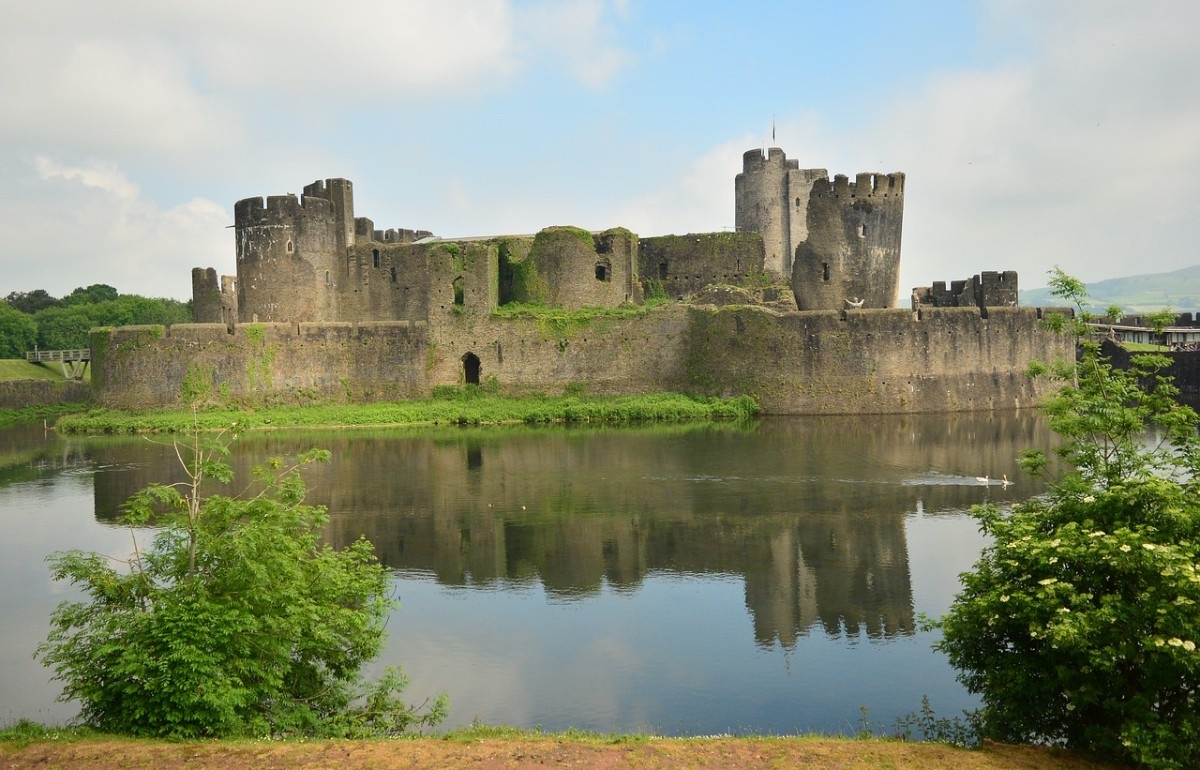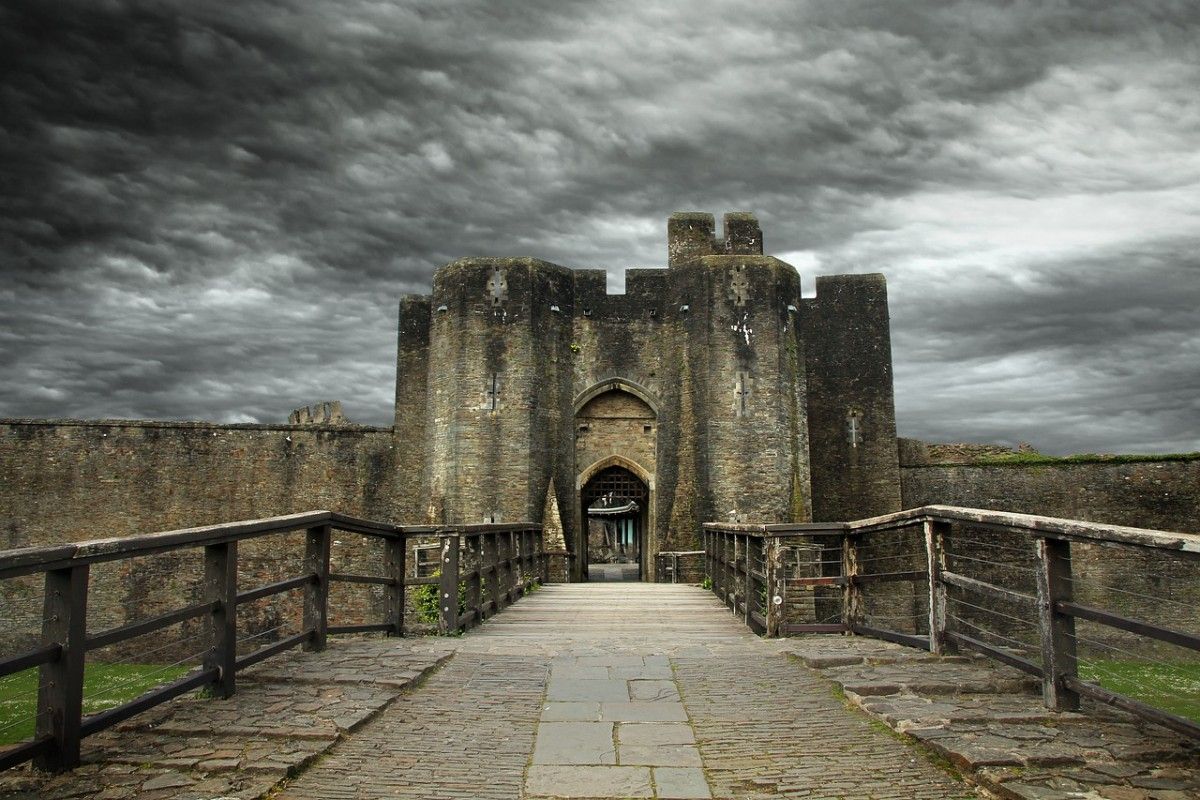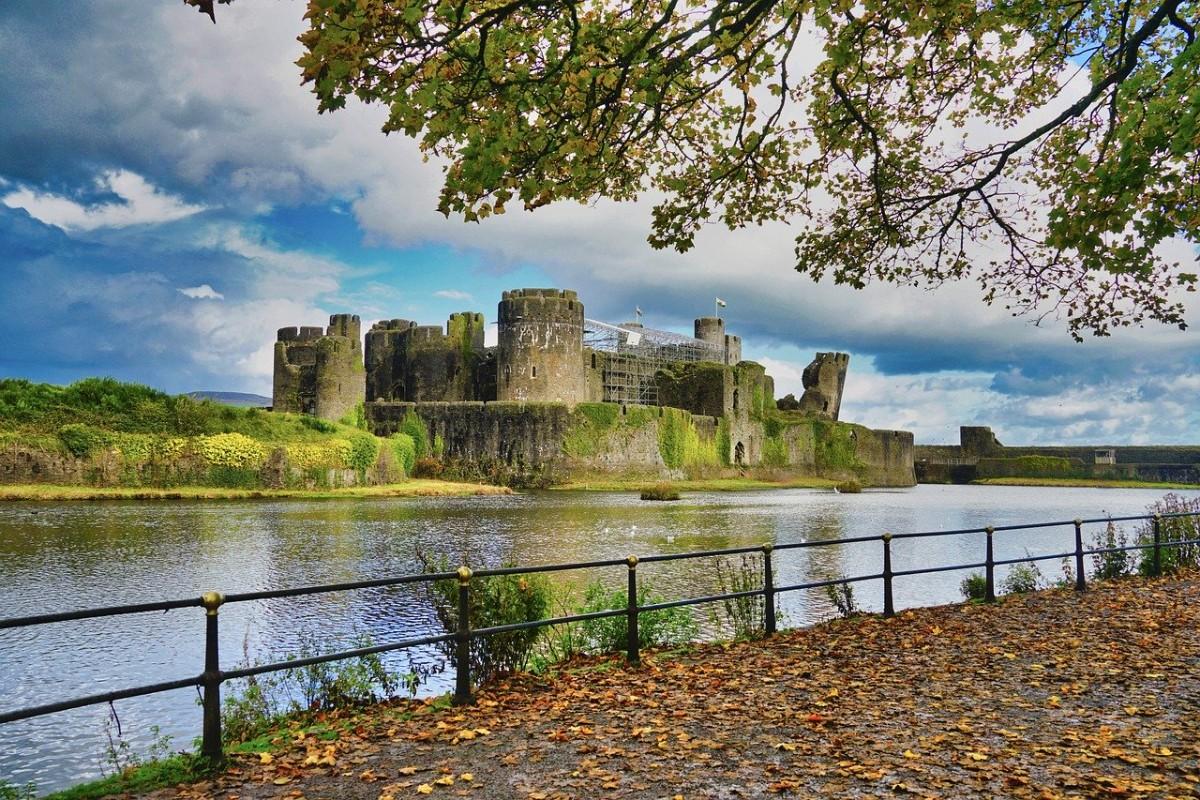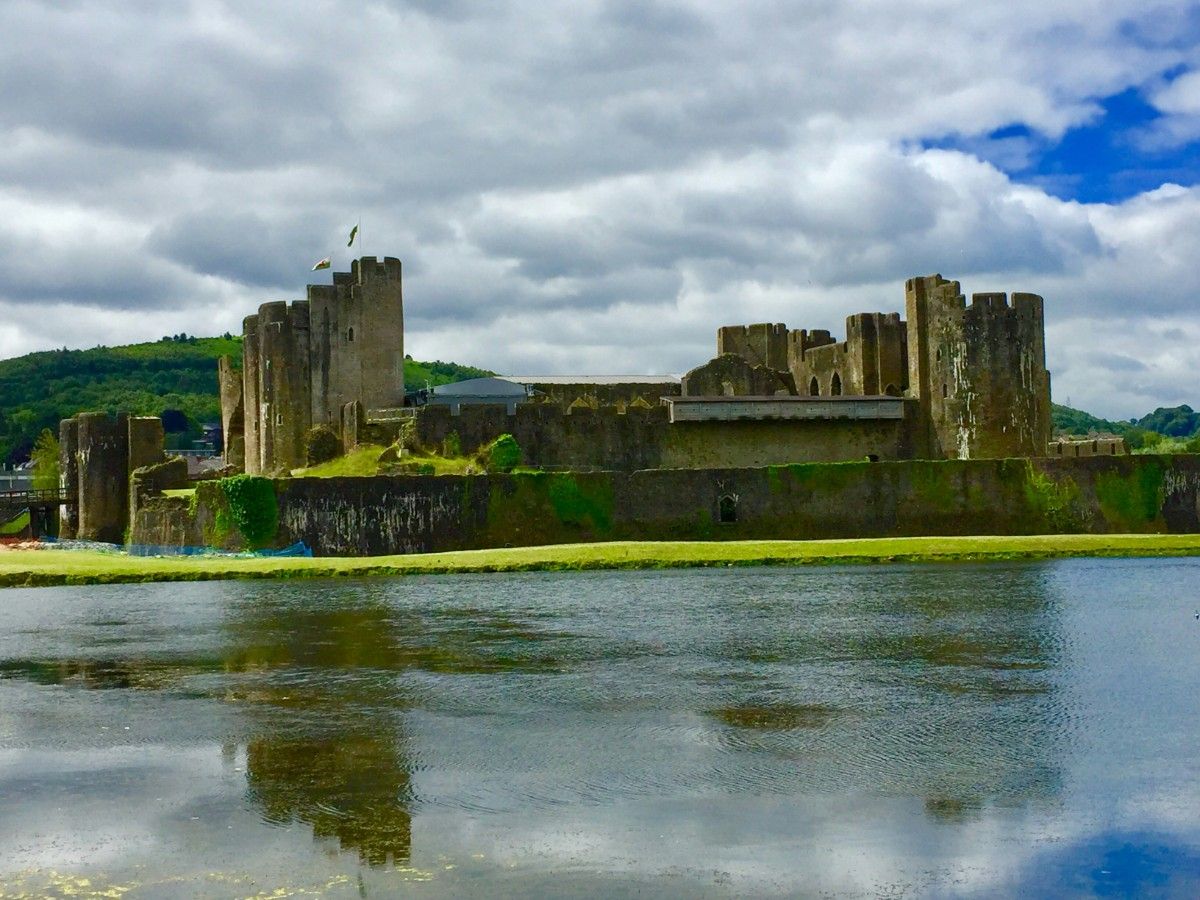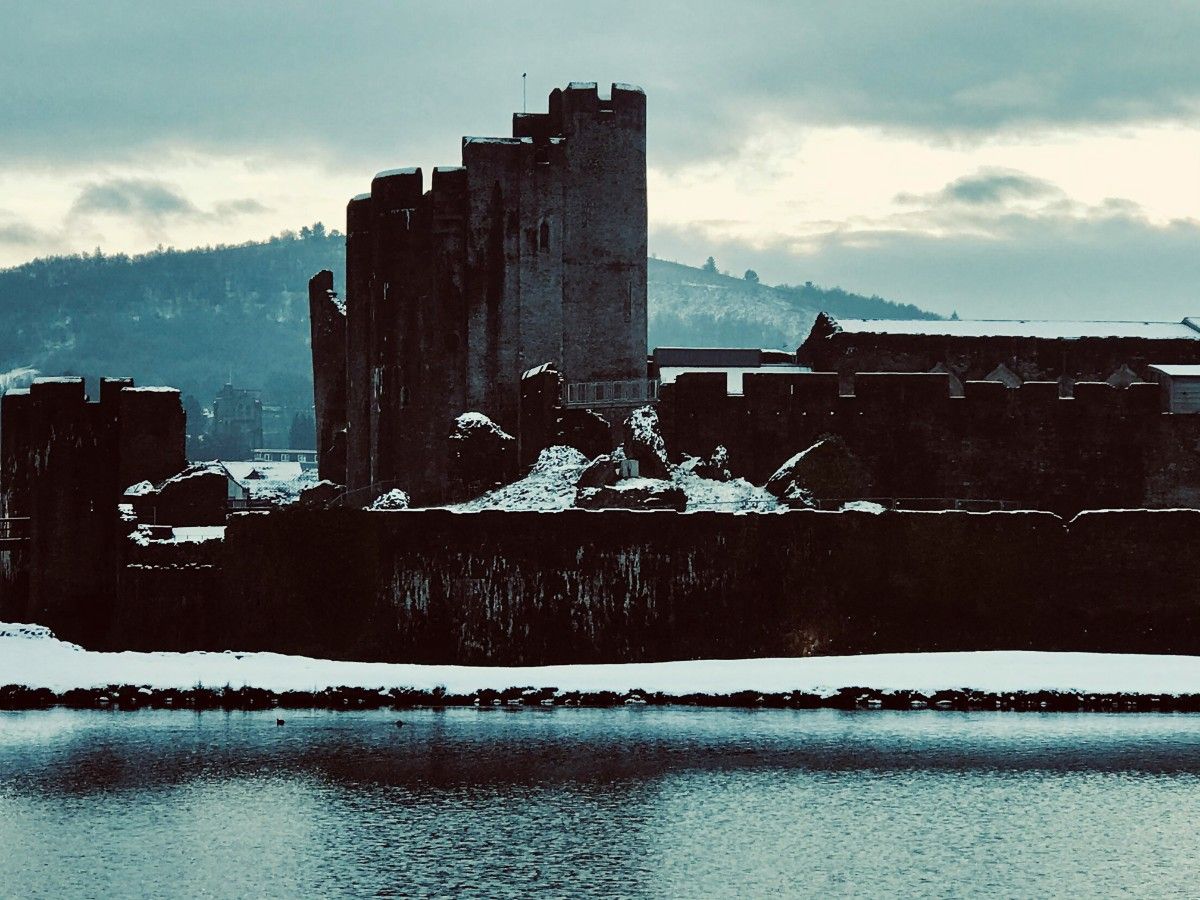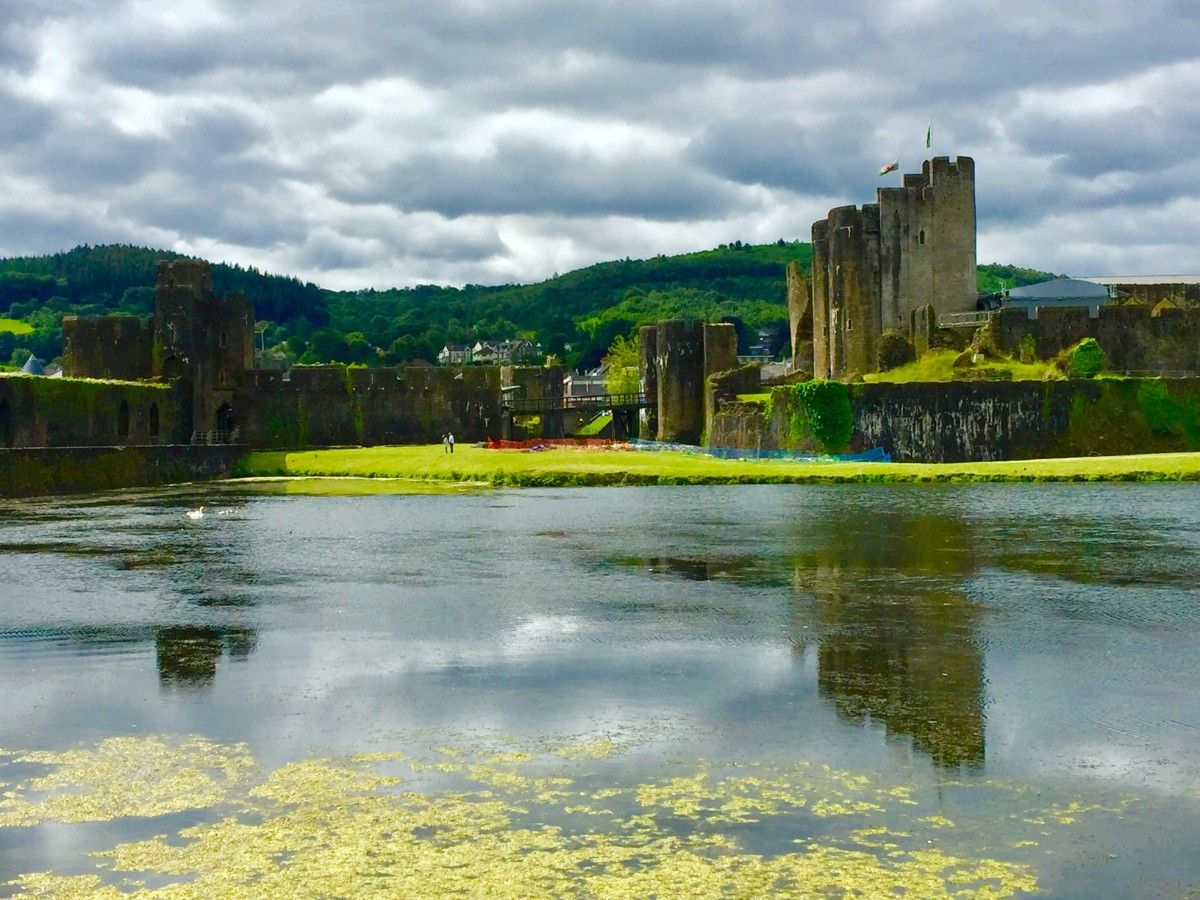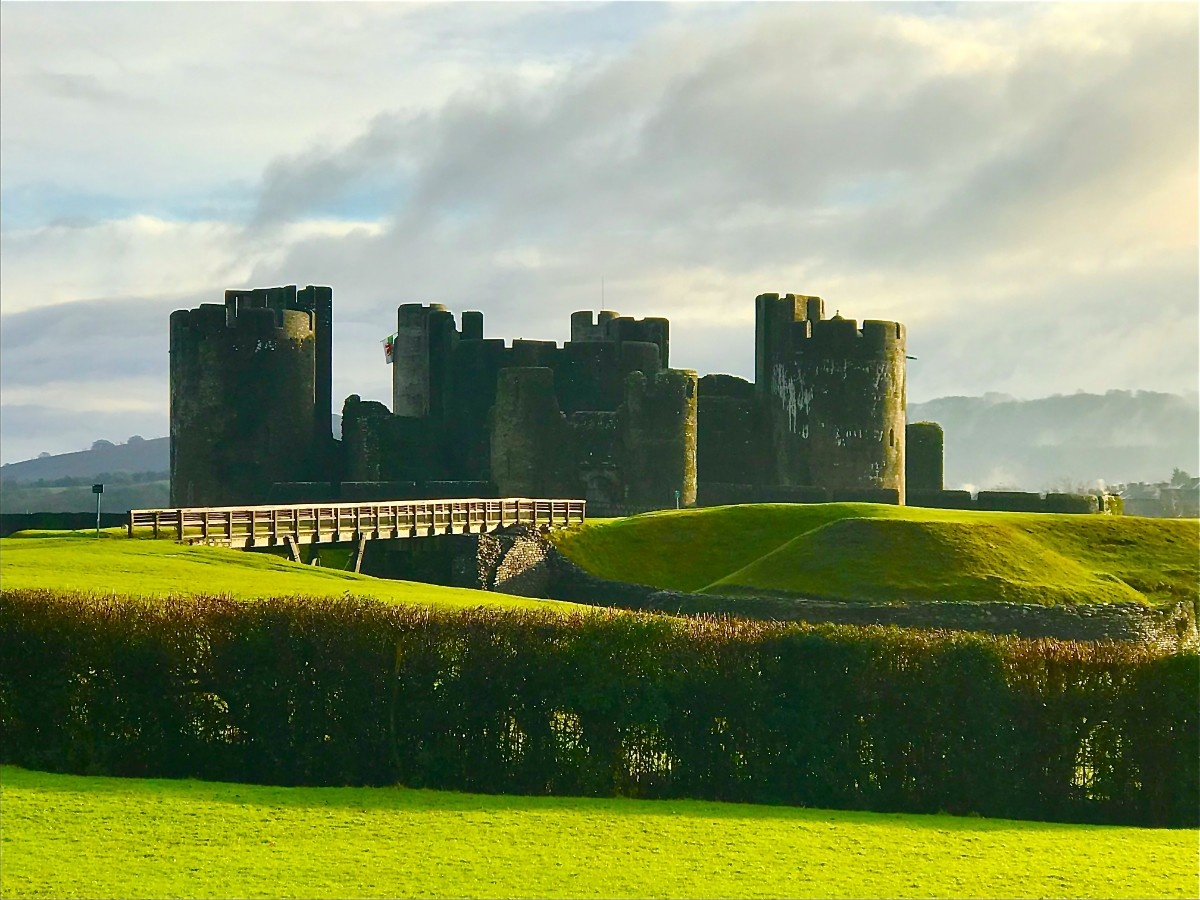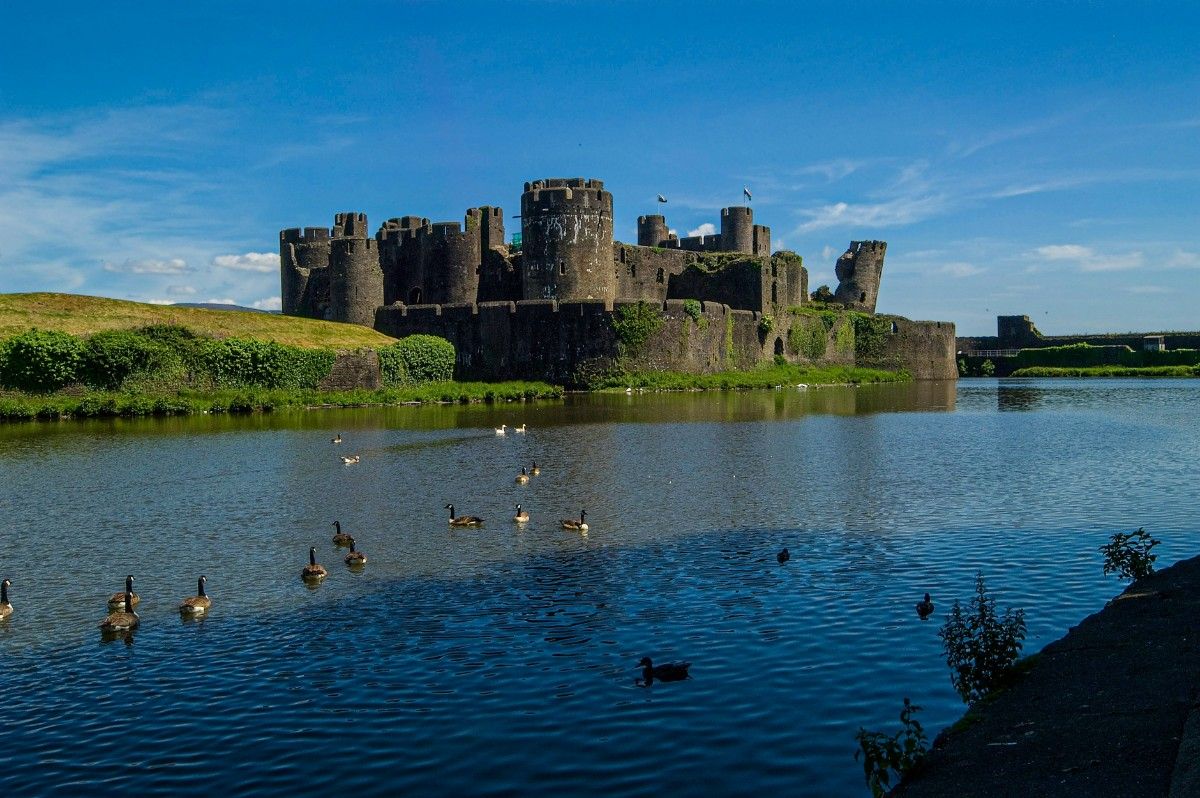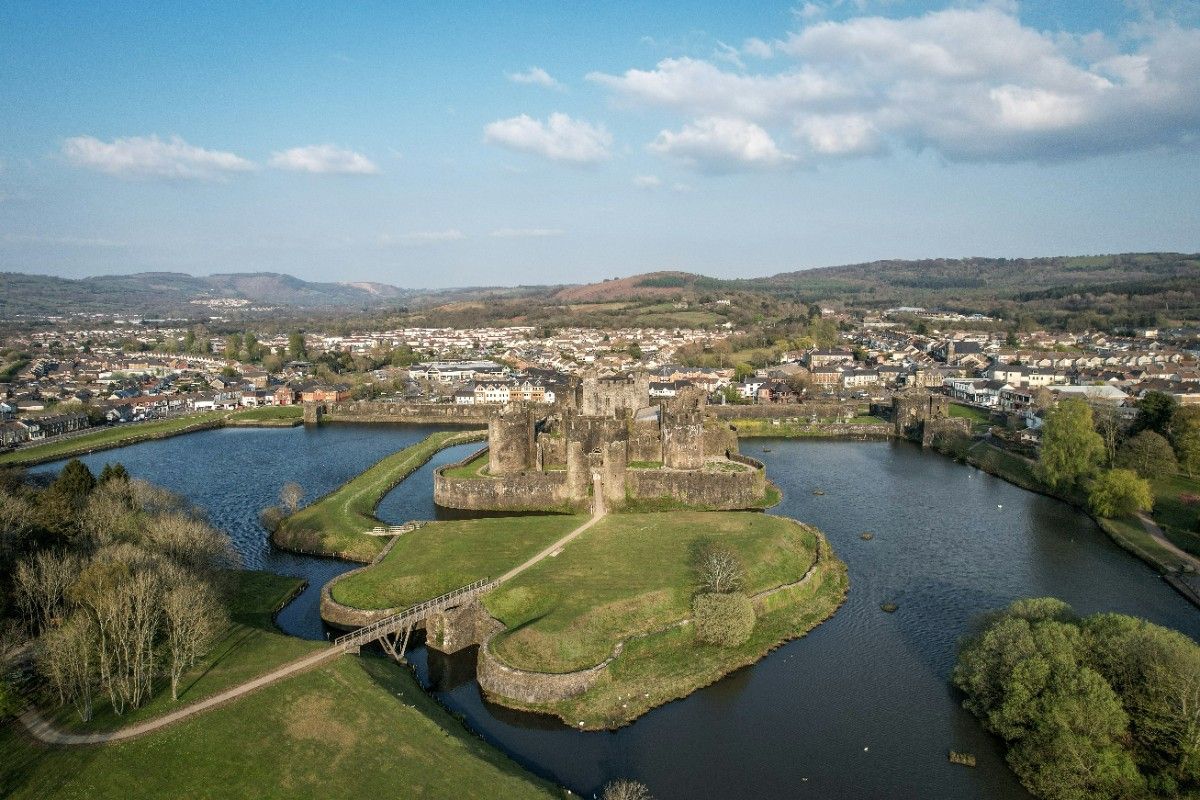The Enchanting History of Caerphilly Castle
The Origins of Caerphilly Castle
Caerphilly Castle, situated in the heart of Caerphilly, Wales, is a magnificent medieval fortress that has captivated visitors for centuries. The castle's construction began in 1268 under the command of Gilbert de Clare, the powerful Earl of Gloucester and Hertford. De Clare, a close friend and advisor to King Henry III, sought to establish a stronghold in the region to consolidate his power and protect his lands from the Welsh princes who had been resisting English rule.
The castle's strategic location, surrounded by water and protected by a series of moats and islands, made it an ideal defensive site. The construction of Caerphilly Castle was a massive undertaking, employing thousands of skilled craftsmen and labourers over the course of several decades. The castle's design was heavily influenced by the concentric castle style, which was popular during the 13th century and featured multiple layers of defences, including outer and inner walls, towers, and gatehouses.
Despite the castle's impressive fortifications, it was not immune to conflict. In 1270, just two years after construction began, the Welsh prince Llywelyn ap Gruffudd launched an attack on the castle, forcing Gilbert de Clare to flee. The castle was eventually completed in 1290, but it would face many more challenges in the centuries to come, including sieges, political upheaval, and neglect.
Caerphilly Castle Through the Ages
Throughout its long and storied history, Caerphilly Castle has witnessed numerous sieges, conflicts, and changes in ownership. In the early 14th century, the castle played a significant role in the Welsh Wars of Independence, serving as a base of operations for the English forces seeking to suppress the Welsh rebellion. The castle was besieged several times during this period, but its formidable defences held strong, and the English ultimately prevailed.
In the centuries that followed, Caerphilly Castle changed hands several times, passing between various noble families and even serving as a royal residence for a brief period in the 15th century. During the English Civil War in the 17th century, the castle was once again caught in the crosshairs of conflict, with Royalist forces occupying the castle and using it as a base of operations against the Parliamentarian army.
Despite the many battles and sieges it endured, Caerphilly Castle managed to survive relatively intact, a testament to the skill and ingenuity of its builders. However, by the 18th century, the castle had fallen into a state of disrepair, with many of its buildings and fortifications crumbling and overgrown with vegetation.
Caerphilly Castle's Restoration and Revival
In the late 19th and early 20th centuries, a renewed interest in medieval history and architecture led to a series of restoration and preservation efforts at Caerphilly Castle. The castle's iconic leaning tower, which had developed a pronounced tilt over the centuries due to subsidence and damage, was stabilised and reinforced, ensuring that it would remain a defining feature of the castle for generations to come.
Today, Caerphilly Castle is a popular tourist attraction, drawing visitors from around the world who are eager to explore its fascinating history and stunning architecture. The castle is managed by Cadw, the Welsh government's historic environment service, which works to preserve and promote Wales's rich cultural heritage.
Visitors to Caerphilly Castle can explore the castle's many rooms and passages, including the great hall, the kitchens, and the towers, and learn about the daily life and culture of medieval Wales through a series of interactive exhibits and displays. The castle also hosts a variety of special events and activities throughout the year, including medieval festivals, themed banquets, and educational programs, providing visitors with a truly immersive and unforgettable experience.
Exploring the Magnificent Architecture of Caerphilly Castle
The Concentric Castle Design
Caerphilly Castle is a masterpiece of medieval military architecture, showcasing the ingenuity and craftsmanship of its builders. The castle's design is based on the concentric castle style, which was a revolutionary development in castle construction during the 13th century. This design featured multiple layers of defences, including outer and inner walls, moats, and towers, making it incredibly difficult for attackers to breach the castle's defences.
The outer ward of Caerphilly Castle is surrounded by a massive curtain wall, which measures up to 19 feet thick in some places and is punctuated by numerous towers and bastions. The inner ward, which contains the castle's main buildings and living quarters, is protected by a second, even more formidable wall, featuring a series of towers and gatehouses that could be easily defended in the event of an attack.
One of the most impressive features of Caerphilly Castle's concentric design is its extensive water defences. The castle is surrounded by a series of moats and artificial islands, which made it virtually impossible for attackers to approach the walls without being exposed to a barrage of arrows and projectiles from the castle's defenders. The water defences also served as a source of fresh water for the castle's inhabitants, ensuring that they could withstand a prolonged siege.
The Great Hall and Other Notable Buildings
At the heart of Caerphilly Castle's inner ward stands the great hall, a magnificent building that served as the castle's social and administrative centre. The hall features a stunning hammerbeam roof, which was a technological marvel of its time, and is decorated with intricate carvings and ornamental features that showcase the wealth and power of the castle's occupants.
Other notable buildings within the castle include the kitchens, which were equipped with large fireplaces and ovens to prepare food for the castle's inhabitants, and the chapel, which features a beautiful vaulted ceiling and stained-glass windows. The castle also contains a number of smaller buildings and structures, including storerooms, stables, and workshops, which provide a fascinating glimpse into the daily life and activities of the castle's residents.
The Iconic Leaning Tower
Perhaps the most iconic and recognisable feature of Caerphilly Castle is its famous leaning tower, which has become a symbol of the castle's unique character and history. The tower, which stands at the southeast corner of the inner ward, leans at an angle of 10 degrees, surpassing even the Leaning Tower of Pisa in Italy.
The tower's tilt is believed to have been caused by a combination of factors, including subsidence, structural damage, and the effects of weathering and erosion over the centuries. Despite its precarious angle, however, the tower remains structurally sound and has been reinforced and stabilised to prevent further movement.
Visitors to Caerphilly Castle can climb to the top of the leaning tower and enjoy breathtaking views of the surrounding countryside and the castle's impressive fortifications. The tower's interior is also open to the public and features a number of informative displays and exhibits that provide insight into the castle's history and architecture.
Caerphilly Castle's magnificent architecture, including its concentric design, great hall, and iconic leaning tower, is a testament to the skill and ingenuity of its medieval builders. Today, the castle stands as a powerful symbol of Wales's rich cultural heritage and a fascinating window into the world of medieval military architecture and engineering.
Caerphilly Castle's Role in Welsh History
The Welsh Wars of Independence
Caerphilly Castle played a crucial role in the Welsh Wars of Independence, a series of conflicts that took place in the late 13th and early 14th centuries. During this time, the Welsh princes, led by Llywelyn ap Gruffudd, sought to resist English rule and maintain their independence. Caerphilly Castle, which was built by the English nobleman Gilbert de Clare, served as a strategic stronghold for the English forces in their efforts to suppress the Welsh rebellion.
The castle's formidable defences and strategic location made it a key target for the Welsh rebels, who launched several attacks on the castle during the course of the conflict. In 1270, just two years after construction began, Llywelyn ap Gruffudd led a siege on Caerphilly Castle, forcing Gilbert de Clare to flee. The castle was eventually completed in 1290, but it would face many more challenges in the years to come.
Despite the Welsh rebels' best efforts, however, Caerphilly Castle proved to be an impregnable fortress, withstanding numerous sieges and attacks over the course of the conflict. The castle's concentric design, with its multiple layers of walls and towers, made it incredibly difficult for attackers to breach its defences, and the English forces were able to use the castle as a base of operations for their campaigns against the Welsh.
The English Civil War
Caerphilly Castle also played a significant role in the English Civil War, which took place in the mid-17th century. During this conflict, which pitted the Royalist forces of King Charles I against the Parliamentarian forces led by Oliver Cromwell, Caerphilly Castle was held by the Royalists and served as a key strategic stronghold in South Wales.
In 1645, the castle was besieged by Parliamentarian forces under the command of Colonel Thomas Horton. The siege lasted for several months, with the Royalist defenders holding out against repeated attacks and bombardments. Despite the castle's formidable defences, however, the Royalists were eventually forced to surrender, and the castle fell into Parliamentarian hands.
Following the end of the Civil War, Caerphilly Castle was partially demolished by the Parliamentarians to prevent it from being used as a stronghold again in the future. However, much of the castle's structure remained intact, and it continued to serve as a symbol of the region's rich history and cultural heritage.
Caerphilly Castle Today
Today, Caerphilly Castle is a popular tourist attraction and a symbol of Welsh national pride. The castle has undergone extensive restoration and preservation work over the years, ensuring that it remains a valuable resource for future generations to learn about and appreciate the rich history of Wales.
Visitors to Caerphilly Castle can explore the castle's many rooms and passages, including the great hall, the kitchens, and the towers, and learn about the daily life and culture of medieval Wales through a series of interactive exhibits and displays. The castle also hosts a variety of special events and activities throughout the year, including medieval festivals, themed banquets, and educational programs, providing visitors with a truly immersive and unforgettable experience.
As a testament to its enduring significance and cultural importance, Caerphilly Castle was designated as a scheduled monument in 1950, recognising its status as one of the most important historic sites in Wales. Today, the castle is managed by Cadw, the Welsh government's historic environment service, which works to preserve and promote Wales's rich cultural heritage for future generations to enjoy and appreciate.
Visiting Caerphilly Castle: Tickets, Opening Times, and Parking
Tickets and Admission Prices
Visitors to Caerphilly Castle can purchase tickets online in advance or at the castle's ticket office upon arrival. As of 2023, the admission prices for Caerphilly Castle are as follows:
- Adults: £9.90
- Seniors and students: £8.40
- Children (ages 5-17): £5.90
- Children under 5: Free
- Family ticket (2 adults and up to 3 children): £26.60
It's worth noting that admission prices are subject to change, so it's always a good idea to check the official Cadw website or contact the castle directly for the most up-to-date information.
Visitors who plan to visit multiple Cadw sites during their stay in Wales may also want to consider purchasing a Cadw Explorer Pass, which provides unlimited access to over 100 historic sites across Wales for a fixed period of time. The Cadw Explorer Pass is available in 3-day or 7-day options and can be a cost-effective way to explore Wales's rich cultural heritage.
Opening Times
Caerphilly Castle is open to visitors throughout the year, with slightly varying opening times depending on the season. As of 2023, the castle's opening times are as follows:
- March 1st - June 30th: 9:30 am - 5:00 pm
- July 1st - August 31st: 9:30 am - 6:00 pm
- September 1st - October 31st: 9:30 am - 5:00 pm
- November 1st - February 28th: 10:00 am - 4:00 pm
It's worth noting that last admission is typically 30 minutes before closing time, so visitors should plan their arrival accordingly. The castle is closed on Christmas Day and Boxing Day, and opening times may vary on other bank holidays or during special events.
To ensure that you have the most up-to-date information about the castle's opening times and any potential closures or restrictions, it's always a good idea to check the official Cadw website or contact the castle directly before your visit.
Parking and Transportation
Caerphilly Castle is located in the heart of the town of Caerphilly, which is easily accessible by car or public transportation. For visitors arriving by car, there is a large pay-and-display car park located just a short walk from the castle's main entrance. The car park is located on Castle Street and is well-signposted from the main road.
Parking fees for the Castle Street car park are as follows:
- Up to 2 hours: £2.00
- Up to 4 hours: £3.00
- All day: £4.00
Visitors can pay for parking using cash or credit/debit card at the payment machines located throughout the car park.
For those arriving by public transportation, Caerphilly is well-served by both bus and train services. The town's main bus station is located just a short walk from the castle, with regular services running to and from Cardiff, Newport, and other nearby towns and cities. Caerphilly also has its own train station, which is located approximately 1 mile from the castle and is served by regular trains from Cardiff and other destinations in South Wales.
Once you've arrived in Caerphilly, the castle is well-signposted and easy to find, with a number of pedestrian routes leading from the town centre to the castle's main entrance. Whether you're arriving by car, bus, or train, visiting Caerphilly Castle is a straightforward and convenient experience, with plenty of transportation options available to suit your needs.
Caerphilly Castle's Iconic Leaning Tower and Dragon Statue
The Leaning Tower of Caerphilly Castle
One of the most striking features of Caerphilly Castle is its iconic leaning tower, which has become a symbol of the castle's unique character and charm. The tower, which is located in the southeast corner of the inner ward, leans at an angle of 10 degrees, surpassing even the famous Leaning Tower of Pisa in Italy.
The leaning tower of Caerphilly Castle is believed to have been caused by a combination of factors, including subsidence, structural damage, and the effects of weathering and erosion over the centuries. Despite its precarious angle, however, the tower remains structurally sound and has been reinforced and stabilised to prevent further movement.
Visitors to Caerphilly Castle can climb to the top of the leaning tower and enjoy breathtaking views of the surrounding countryside and the castle's impressive fortifications. The tower's interior is also open to the public and features a number of informative displays and exhibits that provide insight into the castle's history and architecture.
The leaning tower is not the only notable feature of Caerphilly Castle's southeast tower. The tower also houses a magnificent medieval hall, known as the Braose Gallery, which features a stunning timber roof and decorative architecture that showcases the wealth and power of the castle's occupants. The Braose Gallery is named after the de Braose family, who held the castle for much of the 13th and 14th centuries and were responsible for many of its most impressive architectural features.
Today, the leaning tower and Braose Gallery are among the most popular attractions at Caerphilly Castle, drawing visitors from around the world who are eager to marvel at their unique beauty and learn about their fascinating history. Whether you're a history buff, an architecture enthusiast, or simply looking for a memorable experience, the leaning tower of Caerphilly Castle is a must-see attraction that is sure to leave a lasting impression.
The Dragon of Caerphilly Castle
Another iconic feature of Caerphilly Castle is its impressive dragon statue, which stands guard over the castle's main entrance. The dragon is a powerful symbol of Welsh pride and identity, and its presence at Caerphilly Castle serves as a testament to the enduring spirit and resilience of the Welsh people.
The Caerphilly Castle dragon statue was installed in 2016 as part of a wider project to enhance the visitor experience at the castle and celebrate Welsh culture and heritage. The statue, which stands at an impressive 12 feet tall and weighs over a ton, was created by Welsh sculptor Simon Hedger and is made from stainless steel.
The dragon statue is designed to evoke the legendary Welsh dragon, which has been a symbol of Wales for centuries. According to Welsh mythology, the red dragon represents the Welsh people and their struggle for independence, while the white dragon represents the invading Saxon forces. The two dragons were said to have fought a great battle, with the red dragon ultimately emerging victorious and becoming the symbol of Wales.
Today, the Caerphilly Castle dragon statue serves as a powerful reminder of Wales's rich cultural heritage and the enduring spirit of its people. Visitors to the castle can take photos with the dragon, learn about its significance and symbolism, and even purchase dragon-themed souvenirs and merchandise from the castle's gift shop.
Whether you're a fan of dragons, a lover of Welsh culture, or simply appreciate impressive works of art, the Caerphilly Castle dragon statue is a must-see attraction that is sure to capture your imagination and leave a lasting impression. So why not plan your visit to Caerphilly Castle today and come face-to-face with this incredible symbol of Welsh pride and identity?
Discovering the Castle's Interior and Exhibits
The Great Hall
At the heart of Caerphilly Castle's inner ward stands the magnificent Great Hall, a stunning example of medieval architecture and a testament to the wealth and power of the castle's occupants. The Great Hall was the social and administrative centre of the castle, serving as a gathering place for feasts, ceremonies, and important meetings.
The Great Hall of Caerphilly Castle is one of the largest and most impressive of its kind in Wales, measuring approximately 120 feet long and 40 feet wide. The hall features a stunning hammerbeam roof, which was a technological marvel of its time and is decorated with intricate carvings and ornamental features that showcase the skill and craftsmanship of medieval artisans.
Visitors to Caerphilly Castle can explore the Great Hall and learn about its fascinating history and cultural significance through a series of informative displays and exhibits. The hall also serves as a venue for special events and activities throughout the year, including medieval banquets, music performances, and educational programs.
One of the most impressive features of the Great Hall is its magnificent fireplace, which measures over 20 feet wide and is one of the largest of its kind in Wales. The fireplace would have been used to heat the hall during the cold winter months and to cook food for the castle's inhabitants and guests.
Today, the Great Hall of Caerphilly Castle is a popular attraction for visitors from around the world, who marvel at its impressive architecture and immerse themselves in its rich history and cultural significance. Whether you're a history buff, an architecture enthusiast, or simply appreciate the beauty and grandeur of medieval buildings, the Great Hall of Caerphilly Castle is a must-see attraction that is sure to leave a lasting impression.
The Castle's Exhibits and Displays
In addition to its impressive architecture and historical significance, Caerphilly Castle also features a number of fascinating exhibits and displays that provide visitors with a deeper understanding of the castle's history and the daily lives of its inhabitants.
One of the most popular exhibits at Caerphilly Castle is the "Castle Life" display, which showcases the daily routines and activities of the castle's residents during the medieval period. The exhibit features a range of interactive displays and hands-on activities, including a replica medieval kitchen where visitors can learn about the foods and cooking methods of the time, and a replica medieval bedroom where visitors can try on period clothing and learn about the sleeping arrangements of the castle's occupants.
Another fascinating exhibit at Caerphilly Castle is the "Welsh Castles" display, which provides an overview of the many impressive castles and fortifications that dot the Welsh landscape. The exhibit features a range of informative displays and artifacts, including models of famous Welsh castles, such as Conwy Castle and Harlech Castle, as well as historical documents and photographs that provide insight into the construction and use of these impressive structures.
In addition to these permanent exhibits, Caerphilly Castle also hosts a range of temporary exhibitions and displays throughout the year, focusing on specific aspects of the castle's history or Welsh culture more broadly. Recent exhibitions have included "The Art of the Castle," which showcased the impressive collection of art and decorative objects housed within the castle's walls, and "Dragons in Welsh Culture," which explored the significance and symbolism of dragons in Welsh mythology and folklore.
Overall, the exhibits and displays at Caerphilly Castle provide visitors with a rich and immersive experience that brings the castle's history and cultural significance to life. Whether you're a history buff, an art lover, or simply appreciate the beauty and grandeur of medieval architecture, the castle's exhibits and displays are sure to captivate and inspire you, providing a deeper understanding and appreciation of this incredible historical site.
Special Events and Activities at Caerphilly Castle
The Grand Medieval Melee
One of the most popular events held at Caerphilly Castle is the annual "Grand Medieval Melee," a thrilling reenactment of a medieval battle that takes place each summer. The event draws visitors from around the world who come to witness the spectacle of armoured knights engaging in fierce combat, complete with swords, shields, and other authentic medieval weapons.
The Grand Medieval Melee is a two-day event that features a range of activities and attractions, including live demonstrations of medieval crafts and trades, such as blacksmithing, weaving, and leather-working. Visitors can also enjoy a variety of food and drink stalls, offering a range of traditional medieval fare, such as roasted meats, fresh-baked bread, and mulled wine.
One of the highlights of the Grand Medieval Melee is the jousting tournament, where skilled horsemen compete against each other in a test of strength, skill, and bravery. The tournament is a thrilling spectacle that showcases the pageantry and excitement of medieval combat, with knights clad in gleaming armour and wielding lances as they charge towards each other at full speed.
In addition to the battle reenactments and jousting tournaments, the Grand Medieval Melee also features a range of other activities and attractions, including archery competitions, falconry demonstrations, and even a medieval-themed market where visitors can purchase authentic crafts and souvenirs.
The Grand Medieval Melee is a must-see event for anyone interested in medieval history, culture, and warfare. Whether you're a history buff, a fan of action and adventure, or simply looking for a unique and unforgettable experience, this incredible event is sure to leave a lasting impression and provide a deeper appreciation for the rich history and cultural significance of Caerphilly Castle.
Seasonal Events and Festivals
In addition to the Grand Medieval Melee, Caerphilly Castle also hosts a range of other special events and festivals throughout the year, each celebrating a different aspect of the castle's history and cultural significance.
One of the most popular seasonal events at Caerphilly Castle is the "Christmas at the Castle" celebration, which takes place each December. During this festive event, the castle is transformed into a winter wonderland, complete with twinkling lights, holiday decorations, and even a visit from Santa Claus himself.
Visitors to the Christmas at the Castle event can enjoy a range of activities and attractions, including carolling performances, holiday craft workshops, and even a traditional Christmas market where they can purchase unique gifts and souvenirs. The event is a wonderful way to experience the magic and charm of the holiday season in a truly stunning and historic setting.
Another popular seasonal event at Caerphilly Castle is the "Halloween at the Castle" celebration, which takes place each October. During this spooky event, the castle is transformed into a haunted house, complete with ghostly apparitions, eerie sound effects, and even a costume contest for visitors who dare to dress up in their most frightening attire.
Visitors to the Halloween at the Castle event can enjoy a range of activities and attractions, including ghost tours of the castle's darkest and most haunted corners, pumpkin carving workshops, and even a screening of a classic horror movie within the castle's walls.
Throughout the year, Caerphilly Castle also hosts a range of other special events and festivals, each celebrating a different aspect of Welsh culture and history. These events include the "Welsh Food and Drink Festival," which showcases the best of local cuisine and beverages, and the "Caerphilly Big Cheese Festival," which celebrates the town's famous cheese-making heritage with a range of tastings, demonstrations, and workshops.
Whether you're a foodie, a history buff, or simply looking for a unique and memorable experience, the special events and festivals at Caerphilly Castle are sure to provide a deeper appreciation and understanding of this incredible historic site and the rich cultural heritage it represents.
Staying Safe and Making the Most of Your Visit
Visitor Safety and Accessibility
At Caerphilly Castle, the safety and well-being of visitors is a top priority. The castle is committed to providing a safe and accessible environment for all guests, regardless of age or ability.
To ensure the safety of visitors, Caerphilly Castle has implemented a range of measures and protocols, including regular inspections and maintenance of the castle's facilities and grounds, as well as clear signage and guidance to help visitors navigate the site safely.
Visitors with mobility issues or disabilities can also take advantage of the castle's accessible facilities, which include ramps, lifts, and wheelchair-friendly paths. The castle also offers a range of aids and services for visitors with visual or hearing impairments, including audio guides and large-print materials.
In addition to these measures, Caerphilly Castle also has a team of trained staff and volunteers who are available to assist visitors with any questions or concerns they may have. Whether you need help finding a particular exhibit or facility, or simply want to learn more about the castle's history and cultural significance, the castle's friendly and knowledgeable staff are always happy to help.
To ensure the safety of all visitors, Caerphilly Castle also has a number of rules and guidelines that guests are asked to follow. These include staying on designated paths and walkways, refraining from climbing on the castle's walls or structures, and not touching or damaging any of the castle's artifacts or exhibits.
By following these guidelines and taking advantage of the castle's safety and accessibility measures, visitors can enjoy a safe and enjoyable experience at Caerphilly Castle, while also helping to preserve this incredible historic site for generations to come.
Tips for Making the Most of Your Visit
To make the most of your visit to Caerphilly Castle, there are a few tips and tricks that can help you get the most out of your experience. Here are some of the top things to keep in mind:
Plan ahead: Before you visit Caerphilly Castle, take some time to research the castle's history, exhibits, and events. This will help you prioritise the things you want to see and do during your visit, and ensure that you don't miss out on any of the castle's highlights.
Allow plenty of time: With so much to see and do at Caerphilly Castle, it's important to allow plenty of time for your visit. Plan to spend at least a few hours exploring the castle's grounds, exhibits, and attractions, and be sure to take breaks as needed to rest and recharge.
Wear comfortable shoes: Caerphilly Castle is a large and sprawling site, with lots of uneven surfaces and stairs to navigate. To ensure your comfort and safety, be sure to wear sturdy, comfortable shoes that provide good support and traction.
Bring a camera: With its stunning architecture, beautiful gardens, and fascinating exhibits, Caerphilly Castle is a photographer's dream. Be sure to bring a camera or smartphone to capture all of the incredible sights and moments during your visit.
Take a guided tour: To get the most out of your visit to Caerphilly Castle, consider taking a guided tour. These tours are led by knowledgeable and experienced guides who can provide insights and stories about the castle's history, architecture, and cultural significance that you won't find anywhere else.
Visit during off-peak times: To avoid crowds and long lines, consider visiting Caerphilly Castle during off-peak times, such as weekdays or early in the morning. This will allow you to explore the castle's grounds and exhibits at your own pace, without feeling rushed or overwhelmed.
By following these tips and making the most of your visit, you can fully immerse yourself in the rich history and cultural significance of Caerphilly Castle, and create unforgettable memories that will last a lifetime.
Related Articles

Let us know you agree to cookies
We use marketing, analytical and functional cookies as well as similar technologies to give you the best experience. Third parties, including social media platforms, often place tracking cookies on our site to show you personalised adverts outside of our website.
We store your cookie preferences for two years and you can edit your preferences via ‘manage cookies’ or through the cookie policy at the bottom of every page. For more information, please see our cookie policy.
